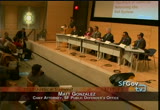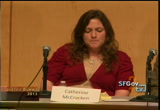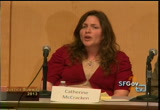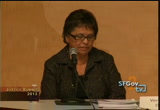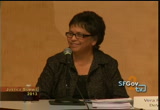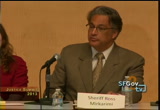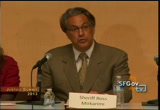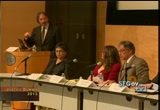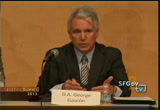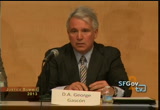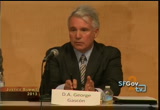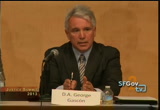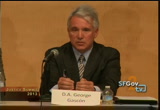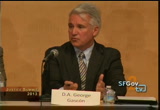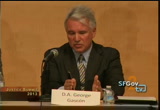tv [untitled] November 8, 2013 1:00am-1:31am PST
1:00 am
institute of policies has called the bail system a failed policy that leads to excessive incarceration and mostly of pretrial detainees who cannot afford to buy their freedom. time and time again commercial bail has proven itself to most effective with those released on assurity bonds with 60 percent less likely to become fugitives. let me introduce the panel, der a dwight is with the association, she owns carson bail bonds and in the industry for 4 decades and former mistake mayor of carson california and helen for the
1:01 am
juvenile and criminal justice system and currently on the and ralph on the commission of san francisco and works closely with the sheriff's department which now leads the program for violent offenders. >> san francisco, he has over 3 decades of experience in law enforcement including his former role as chief of police in san francisco. he's been a critic of current models in the criminal justice system that rely too heavily on incarceration. will looeng is the c e eo of diversion project
1:02 am
from ranging from final alternatives to rehabilitative programs to more comprehensive case management and finally jonathan simon is adrian craig in professor of law, teaches courses on criminal laws, criminal justice, law and consulted culture and law risk and studies. his book includes parole and the social control of the under class 1890-1990 how the war on crime transformed american democracy and created fear. welcome our panelist. [ applause ] >> i'm going to start with catherine mccrack in, the organization on juvenile and criminal justice has done extensive reach on the bail system and pretrial detention.
1:03 am
is the system currently working would you say and what reforms would you support? >> thank you for having m e here today. the center for criminal justice has released a report last year that did examine the bail industry particularly around the lobbying effort. i want to talk a little bit about the criticisms of the commercial bail industry that has been reoccurring over the years and these date back as far back as to the 1920s that the commercial bail doesn't just a minute, discriminate those who can't afford bail. counties are responsible for an increased
1:04 am
number of level. we have to better utilize our jail space and those confined to jail are the ones is that need to be there. when they come, they have to release inmates and that's not a systemic way. some counties release first ones in and out. the criticism about the bail industry that it doesn't really address -- well, it affects individuals who are not able to post bail, are not afforded the same due process as other individuals that can affect their experiences through their trials. so, for example, individuals who are
1:05 am
unable to post jail or are in custody through the hearing trial process, are attending their hearings in their county issued blues, they are also potentially attending hearings in handcuffs and that's the perception they have on these individuals and additionally the folks that are not able to post bail are affected through collateral consequences by being potentially unnecessarily detained if they do not pose a risk to public safety. they are affecting their ability to continue with their employment, education or family responsibilities. so the center on criminal justice would advocate for an increased use or implementation of pretrial
1:06 am
services at the local level and some on this panel will speak with more detail on that. >> let me ask miss dewint that you are obviously part of the bail association and the president of the organization, you have decades of experience. critics have argued that your association and other associations like it use their influence by way of lobbying to protect the groups financial interest. i'm wondering if you can respond to that and perhaps give us an idea what kind of lobbying your organization does? >> thank you. first of all let me thank jeff and the san francisco public defenders office for this 10th year of the justice submit summit. thank you and i don't have a
1:07 am
prepared speech. i do want to address some of these misconceptions. there is a bail reform and we are part of the reform. we are proud to say that we are part of our regulatory agency with the department of insurance to reestablish the industry. but alongside of that we are not a one size fits all industry. there is a place for the criminal justice system as well as the criminal bail industry. now we have testified along with catherine, our lobbying effort are basically this is what we look like. this is the lobbyist. we are not a high paid, i represent the mom and pop businesses throughout the state of california and certainly although hopefully our assurity companies employ their lobbyist. this is what it
1:08 am
looks like. it not the chico's bail bonds. we are mom and pop and the majority of our agencies are owned by women. i'm eye i want to have the opportunity to say what we mean. legislator coming this year is what we are looking at at high cost of bail. yes it has to be locally controlled. we have nothing to do with this. i'm from los angeles county and let me tell you bail schedules are very high out there. but we work with the families, co-workers, and employers that want that person out of jail where they can continue to flourish in their society. the issue of -- well
1:09 am
the pretrial is there is a misconception about which is fair and which isn't fair. i have to say for the sake of public safety, we offer a little bit of the bjs study that our statistics is true because we incorporate other people with a part of the skim in the game, if you will, the family and members and we do a better job of seeing people return to court. we don't judge, we just return them to court and make their appearances. >> there are a lot of organizations throughout the state that, you know, kind of pull their resources together to be able to engaged in some lobbying, i think it true for some associations and there is some lobbying for the california's association. do you know how much your organization spends on lobbying?
1:10 am
>> we don't even have a paid lobbyist. but the sure ityty company there is a guess. i have no idea what their figure would be. >> i understand that you are also amen of american bail coalition? >> it's a representative of the assurity companies. those are the big guys that we get our paper to write with. i'm not a member of the american coalition. that's for assurity companies. >> the bailing corporation is that what you are with? >> yes. the california bail association has been around for 32 years. we are colleagues and share mutual goals. >> let me move on to sheriff, in 2010, 70 percent of
1:11 am
california jail's population were there to hear their cases. the national average was 61 percent. i'm wondering if you are tell us what the percentage is in san francisco jail and i'm wondering if you can tell us about the sheriff's power to control the pretrial population? >> first of all, thank you for public defender jeff in an allowing us to participate in your 10th justice summit and also in recognizing the important anniversary. our statistics in the city of san francisco are higher. 75 percent of our jail population is a pretrial felony population. i think you have to put some numbers in context as
1:12 am
to who is our inmates in san francisco city county jails. the population demography reflects 60 percent african american inside the county jail system, 21 percent white and 15 percent latino. we have done studies in the past that show that at least a 3rd of our jail population would be eligible for some form of pretrial release through programs that have been designed through pretrial release, they have been very effective. i know will looeng of our shop can report on figures. i can give you ideas of jail dates that have been avoided. the numbers are significant. supervised release, we saved 43551 jail
1:13 am
days. for 2011, with court atable accountable was 88059 and o.r. is 25,000. county sheriff's have been empowered to be able to use their discretion for early release and to use our discretion to help reroute people into alternatives to incarceration with monitoring release. but in the program we have under crowding. our jail maximum population is about 2400. our
1:14 am
average for the last 15 months has been under 1600 inmates per day. we are doing a great job as a city and what lines up between the public defender and district attorneys and the number of the parties at the table for san francisco is finding in rhythm on what we can do instead offen incarcerating as a first response but a latter response. i would like to see where this progressive outlook is going. i also this i that 120301 in the penal code allows the supervisors to amend the translation for county sheriff to rewrite that eligiblity for
1:15 am
early release even fore jail systems that are not over crowded. i think coming out of here is a potential reform as one who tries to second reconcile the bail bonds industry and the equity that exist from people who can not afford jail which are people of color and come from disadvantaged communities and the nationals in the state are affirmed in a city like san francisco. we should not rest on our laurls in san francisco and realize that based on the demography that what exist inside our jail system continues with the management that we do want to consider some alternatives in the penal code those opportunities are providing for the county
1:16 am
governments and county board of supervisors that empowers our local criminal justice partners to do just that. >> let me ask you, does the sheriff have the power to release an inmate despite the fact that a judge has set bail and they are unable to pay? >> we do. we have that through electronic monitoring or some other supervised facility. it has not been well applied. >> is that the only instance that you are given that power in? electronic monitoring? >> through some kind of work if furlough or alternative situation. >> keep in mind, the county has been fairly light and i think both incarceration and those not in incarcerated because of
1:17 am
credit time served they are doing a decent job of manage that go population because we didn't send many in the first place. that is giving us a leg up in a sophisticated and complicated population that has been exposed to the system and so that we can accelerate the process of reentry so we have a better exit plan so they hopefully do not return. >> let's say you are dealing with somebody coming into system at their arrangement bail gets set and they are not even ready to post bail. do they have any power to release inmates where a bail has been set by a judge pending their trial? >> it depends on the
1:18 am
classification of that inmate on a very case by case assessment because no sheriff would want to risk basic liability if something went awry. when they are high enough to give us a leap for that. our confidence level would have to be at a complete optimum to be sure there is not a blow back from our policy. >> let me ask joe sarco on that most of us believe there is an an evaluation that a judge makes in making a determination whether someone whether or not should be released on their own rerecog nizance. your lawyers
1:19 am
are in court everyday at arraignments arguing for monetary bail or agree that a defendant should be released on their own recog nizance. what factors do you think are most important when district attorneys in a court are making that recommendation to the judge? >> yes. thank you for the opportunity and the public defenders office and jeff, for pro providing this forum. i believe that pretrial release should be based on three things, risk of violence, risk of reoffending or flight risk. i think that we have inject ed for many many years a commercial value to safety that
1:20 am
i think needs to be reevaluated for the reasons that have been stated. the reality is that the current commercial value to the pretrial release has not only had an impact for minorities. 24 percent of hispanics do not get to bailout. about 35 percent of african americans do not get to bailout whereas white americans are right around 27 percent. but i think the problem we face is that we have not come up with good predictors of risk. and often the dialogue that occurs between a judicial officer and a district attorney and a defense attorney where there is a public defender or private counsel is really a discussion that is based on perhaps the individuals current offense, it maybe based on the individual's
1:21 am
history of offending. it's really not a scientific way of having a discussion around safety and around flight risk. often many of the people that are given very high dollar bails are people where the bench is looking where all the intents and purpose there is no real bail that is because this person is a real risky person or perceived to be risky and perhaps a better response to this ought to be if we think this person and property is risky, there should be no bail. conversely if there is a way to evaluate that a person is not a danger to society and because of their evaluation of them that they will show up for
1:22 am
court they will be released on their own recognizance. we have a high level of percentage wise of pretrial detentions as opposed to other counties. part of reason for that is because we have a very high level of alternative resolutions. for other counties for instance are barely using split sentences on the realignment. my option is meeting the state on the use of split sentencing which means a lot of people are out of jail way before they would be in any other community. these are post sentencing people that in another county would be county towards the racial population in the circle they are in the community. there is also a large number of people in place on community base supervision where another communities these people would be doing their time and incarceration. that
1:23 am
has a tendency to impact the ratios because on the sentencing part of it, we are much more likely to release somebody into community that many other counties are. and we believe that has worked well for us. the crime rate has not gone up, in other areas it's low. we are the only one to do so and we are the only urban counties that have under population but the other ones are rural counties. i believe we are doing well. i believe with the sheriff's because we are doing well does not mean that we can't not do better. i believe we can do better. that someone is going to stay in custody in a pretrial setting should be really based on risk, risk of violence, risk of reoffending and/or is a flight
1:24 am
risk. i think also as we looking at this, we need to push the whole concept of adjustment reinvestment. that needs to go to places to keep people coming into system in the first place. prevention models, more going towards public education and health is a long-term investment instead of putting into criminal justice system. i hope as we continue to develop this and other areas that we are focused in the whole concept and where we can take money away without risking public safety and putting money in social services that are more likely over a long period of time to continue to reduce crime and continue to create a safe environment and environment where we would not necessarily need to have this large
1:25 am
investment in the criminal justice system. [ applause ] >> to mr. gas skon. if we were to eliminate money bail in effect turn over a decision whether or not someone is in custody to a judge whether or not they have been violator likely to reoffending or a flight risk, do you think that kind of system would likewise get accused of discrimination against the poor or racial minorities or do you think it would be more fair? >> i think it would be more fair. if you look at the fact that hispanics for instance are under the current system 4 percent more likely to be held on a pretrial setting than whites, 27 percent, we can
1:26 am
show there is a disparity there. if we create a model that is based on evidence base risk factors that can be applied to the individual and the setting of that individual and can be done objectively not because an officer is making a decision but putting some kind of value system to those factors that are likely to impact risk. i think we are probably going to have a much more equitable system than we are having today. having said that, i think we need to recognize that our criminal justice system is anything but equal. we have had a very in equitable system for many years. i don't think anybody in this room have question the
1:27 am
fact that african american and minorities are always more negatively impact by the criminal justice system. the improvement of that process is a journey. i don't think it's a destination, but i think we can have a no commercial bill system that could be done more fairly if it is done based on some clear objectives in factors that are prestated so it's not something that is simply left to the individual judgment of a judicial officer to do so arbitrarily. >> let me ask mr. looeng, perhaps you can tell the audience about the organization you lead and your experience with risk in needs assessment tools or the kind of evidence based factors that mr. gas skon is referencing. sn >> thank you, jeff, the project
1:28 am
has in existence since 1976 and it's a non-profit organization. when we first came across this was a heavily needs base. we provide treatment and with the idea that you are going to impact the failure to appear or appearing in court and obviously recidivism. that's now jumping forward 30 or 20 years. in the last five years particularly you have heard these words in fact chief still spoke about it, evidence base. in the last decade the single biggest change in our social services has been the use now of technology and i see it sort of akin to and i read an article recently. what you are trying to do now is obviously
1:29 am
face risk decisions now on much more empirically based situation. now the pretrial diversion project and pretrial release is really the hummer so to speak. the district attorney and sheriff set the policy. we have been working or this base practice for years. obviously the major stake holders, the district attorneys, the she
1:30 am
rifs. just to give you an idea of the scope of what we are doing. approximately 1100 people come out of jail from our program. this time we are targeting somewhere around 1500 cases. prior to the last 3 or 4 years, the data that is now coming in, recidivism is around 6 or 7 percent, failure to appear rate or people to appear in court is lower. they are walking people out of jail. we've just come out of a difficult 4-5 years and that is budget years with a lot of social services being cut and really at the end of the day when you are talking about
42 Views
IN COLLECTIONS
SFGTV2: San Francisco Government Television Television Archive
Television Archive  Television Archive News Search Service
Television Archive News Search Service 
Uploaded by TV Archive on

 Live Music Archive
Live Music Archive Librivox Free Audio
Librivox Free Audio Metropolitan Museum
Metropolitan Museum Cleveland Museum of Art
Cleveland Museum of Art Internet Arcade
Internet Arcade Console Living Room
Console Living Room Books to Borrow
Books to Borrow Open Library
Open Library TV News
TV News Understanding 9/11
Understanding 9/11